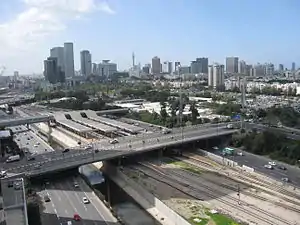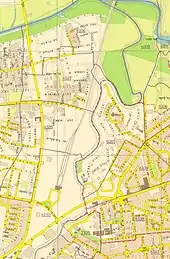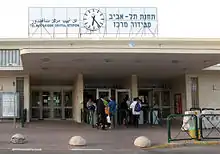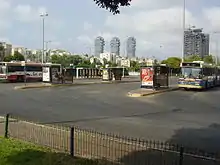Tel Aviv Savidor Central railway station
The Tel Aviv Savidor Central railway station (Hebrew: תֵּל אָבִיב סָבִידוֹר מֶרְכָּז, Tel Aviv Savidor Merkaz, Arabic: تل أبيب مركز سافيدور) is an Israel Railways train station in Tel Aviv. It is one of the main railway hubs of Israel, located in the eastern part of Tel Aviv, on the border between Tel Aviv and Ramat Gan. The station was opened to the public in November 1954 under the name Tel Aviv Central, and throughout its history was also widely known as Arlozorov station due to its location in the eastern end of Arlozorov street, Tel Aviv, and next to the Arlozorov Interchange on the Ayalon Highway.
Tel Aviv Savidor Central תחנת תל אביב סבידור מרכז تل أبيب مركز سافيدور | |
|---|---|
| Israel Railways | |
 | |
| Location | 10 Al Parashat Drakhim St., Tel Aviv |
| Coordinates | 32°05′02″N 34°47′54″E |
| Platforms | 3 |
| Tracks | 6 |
| Construction | |
| Parking | 3000 payable spaces |
| Bicycle facilities | 50 spaces |
| Disabled access | Yes |
| History | |
| Opened | 3 November 1953 |
| Rebuilt | 1988 |
| Electrified | 5 April 2020 |
| Passengers | |
| 2010 | 9,722,274 |
Most of Israel Railways' lines (with the exception of Haifa-region suburban trains) make a stop or terminate at the station. It is the busiest heavy-rail train station in the country in terms of passenger movements, serving a daily average of 70,073 passengers in December 2014. It has three island platforms serving a total of six tracks, with another island platform serving future tracks 7 and 8 planned for addition by the late 2020s as part of the four-tracking project of the Ayalon Railway.
Tel Aviv Central is located between a large bus terminal to its west and Ramat Gan's Diamond Exchange District to its east. Like all railway stations in Tel Aviv, the tracks lie between the southbound and northbound lanes of the Ayalon Highway. They are connected by escalators, stairways and elevators for disabled persons to a bridge which links them to the terminal building (on the Tel Aviv side) and the Diamond Exchange District (on the Ramat Gan side). In 2018 a northern access terminal fronting Modaii bridge opened, adding a third passenger entry and exit point out of the station and facilitating additional access to the Diamond Exchange District. An underground station of the future Red Line light rail is being built at the site to be opened by late 2022.[1]
The station is named after Menachem Savidor, Israel Railways' chairman between 1954–1964 and later the speaker of the Knesset.
History


The railway station was originally the southern terminus of the Coastal railway line, which opened on November 3, 1954 and reached what was then the northern fringe of Tel Aviv. For the next four decades, it only handled trains to and from the north, and was colloquially known as Tel Aviv North station. This colloquial name could be ambiguous because between 1949 and Tel Aviv central's opening in 1954, "Tel Aviv North" was the official name of the Bnei Brak railway station. Railway service to and from destinations south of Tel Aviv was provided from Tel Aviv South railway station, which was not connected with Tel Aviv Central.
In its initial configuration as a terminal station, the passenger platforms were located directly north of the terminal building, to the west of their present location. In 1988, the tracks leading to the station (along the present Pinchas Sapir Street) were shifted eastwards as works on the Ayalon Highway and railway progressed southwards. The station's platforms were then moved to their current location and a pedestrian bridge over the Ayalon Highway was built to connect them to the terminal building to the west. The station with its relocated tracks was opened to the public on January 10, 1988, and the official opening took place on May 3 of the same year.[2] In 1993 the station ceased being a terminal station when the Ayalon section of the coastal railway was extended to link with the Jaffa–Jerusalem railway in southern Tel Aviv. At that point, the little-used Tel Aviv South station (which unlike Tel Aviv Central was not located on the Ayalon railway) was closed for passengers and services operating to it were routed to the more conveniently-located Tel Aviv Central station instead. Between the closing of the Tel Aviv South railway station and the opening of Tel Aviv HaShalom railway station in 1996, Tel Aviv Central was the only active passenger railway station in Tel Aviv. Nowadays, Tel Aviv Central is one of four active passenger railway stations located within Tel Aviv's municipal borders.[3] In 2005 a third island platform serving tracks 6-7 was added to the station.
Until 1980 the head office of Israel Railways was located at the Haifa Central Station when Tzvi Tzafriry, the general manager of Israel Railways decided to move the head office to Tel Aviv Central.[4] In 2017 Israel Railways' head office was relocated from Tel Aviv Central to a new office complex situated on the grounds of the Lod railway station.
Electrification works in the station began in 2019 and were completed on 5 April 2020.
Central bus terminal

The central bus terminal (מסוף רכבת מרכז), Arlozorov Terminal or Tel Aviv 2000 Terminal (מסוף 2000) is a major bus station located next to the Tel Aviv Central railway station, near the border of Tel Aviv and Ramat Gan, next to the Ayalon Highway and the junction of several traffic arteries: Jabotinsky Road that leads to Ramat Gan, Bnei Brak and Petah Tikva, Begin Road that goes to south Tel Aviv, Namir Road to north Tel Aviv and further to Highway 2 and Arlozorov street westward to the sea. Arlozorov/2000 Terminal should not be confused however with the Tel Aviv Central Bus Station, located in southern Tel Aviv – nearby the HaHagana railway station.
Together, the bus and train terminals at the site constitute a major transportation hub that plays a significant role in both short- and long-distance public transportation in Israel. The Tel Aviv Light Rail will also have a station in the same area. As of 2016 the bus terminal serves about 120,000 passengers daily.
Buses of Egged, Dan, Kavim, Metropoline, Afikim, Superbus and Nateev Express bus companies stop at the terminal and surrounding streets.
The terminal lies in the open air, unlike the central bus stations in Tel Aviv, Jerusalem and some other cities, which are inside large buildings that also double as shopping malls. The open-air central bus terminal underwent renovations in 2018-2019.
References
- Cohen, Moshe (4 October 2020). "עבודות הרכבת הקלה בתל אביב נכנסות לשלב הסופי" [Red Line Works in Tel Aviv Entering Final Stage]. Maariv (in Hebrew). Retrieved 6 September 2020.
- Cotterell, Paul (December 1989). Rothschild, Walter (ed.). "All Change at Tel Aviv". HaRakevet (6).
- Israel Railways Lines and Stations
- "From press release of May." (Press Release May 2009) (Archive) Israel Railways. Retrieved on 9 April 2013.
External links
| Wikimedia Commons has media related to Tel Aviv Central Savidor train station. |
| Preceding station | Israel Railways | Following station | ||
|---|---|---|---|---|
| Towards: Nahariya Tel Aviv University |
Nahariya–Haifa–Tel Aviv–Ben-Gurion Airport–Modi'in Inter-City Service |
Towards: Modi'in Central Tel Aviv HaShalom | ||
| Towards: Herzliya Tel Aviv University |
Jerusalem–Tel Aviv–Herzliya Inter-City Service |
Towards: Jerusalem–Yitzhak Navon Tel Aviv HaShalom | ||
| Towards: Nahariya Tel Aviv University |
Nahariya–Haifa–Tel Aviv–Be'er Sheva Inter-City Service |
Towards: Be'er Sheva Center Tel Aviv HaShalom | ||
| Towards: Haifa Center HaShmona Tel Aviv University |
Haifa–Tel Aviv–Jerusalem Inter-City Service |
Towards: Jerusalem Malha Tel Aviv HaShalom | ||
| Towards: Binyamina/Netanya Tel Aviv University |
Binyamina/Netanya–Tel Aviv–Rehovot/Ashkelon Suburban Service |
Towards: Rehovot/Ashkelon Tel Aviv HaShalom | ||
| Towards: Netanya Tel Aviv University |
Tel Aviv–Rishon LeZion Suburban Service |
Towards: HaRishonim Tel Aviv HaShalom | ||
| Towards: Ra'anana West Tel Aviv University |
Hod HaSharon–Tel Aviv–Rishon LeZion–Ashkelon–Be'er Sheva Suburban Service |
Towards: Be'er Sheva Center Tel Aviv HaShalom |